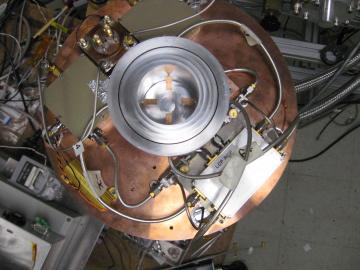Instrumentation

The C-BASS receiver is a hybrid of a broad-band correlation polarimeter and a correlation radiometer. The polarimeter design is optimised for extremely low cross-polarisation, while the radiometer uses a pair of temperature-stabilised loads to allow accurate total power measurements.
To achieve our science goals, the minimum requirement is an rms noise of <0.1 mK per pixel, and an accuracy of 5% on scales up to 10 degrees. In practice the noise will be substantially lower. Our goal is to reduce systematic errors well below the 5% level, and on angular scales up to the quadrupole, in order to complement future B-mode experiments.
| Sky-coverage: | All-sky |
| Angular resolution: | 0.73 deg (43.8 arcmin) |
| Sensitivity: | <0.1 mK/beam r.m.s. |
| Stokes coverage: | I, Q and U |
| Tsys: | <20 K, including sky |
| Frequency/bandwidth: | 1 GHz bandwidth, centered on 5.0GHz |
| Northern site: | OVRO, California, latitude 37.2 deg., 6.1m dish |
| Southern site: | meerKAT Karoo site, South Africa, latitude -30.7deg., 7.6m dish |
The C-BASS receivers are a hybrid of a correlation radiometer and a correlation polarimeter. This receiver architecture was chosen to provide stable measurements of both total intensity (Stokes I) and linear polarisation (Stokes Q and U). C-BASS North covers the 4.5 to 5.5 GHz band in a single analog channel with a custom digital readout, while the C-BASS South receiver implements the same architecture with a digital back-end that also provides spectral resolution within the band.
Schematics of the C-BASS receivers are shown below.

Block diagram of common frontend of the CBASS North and South receivers

Block diagram of analogue backend of the CBASS North receiver

Block diagram of digital backend of the CBASS South receiver
Some of the features of the receiver which are intended to reduce systematics are:
- Temperature-stabilised loads are used to obtain accurate total power measurements.
- Each circular polarisation is spread over two amplifier chains to lessen the effects of gain drift (a balanced receiver).
- All the signal paths are phase switched with orthogonal Walsh functions.
We have designed all of the components in the receiver with low cross-polarisation as our primary consideration. One of the major technical hurdles we have overcome was designing a broadband, compact, low cross-polarisation Orthomode Transducer (OMT).

Interior of CBASS North cryostat, showing the 4-probe Orthomodes tranducer, linear to circular polarisation converter and temperature controlled load.
In addition to the use of cold loads and other receiver design features, we reduce systematics by:
- Using optical baffling to shield the receiver from polarised ground-reflected radiation.
- Rapid scanning of the telescope.
- Highly-redundant coverage at a variety of scan crossing angles.
The optical layout and feed-horn have been optimised for minimal sidelobes and cross-polarisation. The northern telescope was donated to the project by the Jet Propulsion Laboratory, having been designed as a prototype for an array element for the Deep Space Network. It has a 6.1-m single-piece reflector. The southern telescope was donated by Telkom SA to SKA South Africa and was originally designed for the ground segment of a low-earth orbit telecommunications satellite constellation. It has a segmented 7.6-m primary with twelve radial panels.
In order to use the same feed-horn for both antennas and to ensure matched beam properties for the southern and northern surveys, the two antennas use different optical configurations for the two telescopes -- the northern antenna uses Gregorian optics, while the southern antenna uses Cassegrain optics. The smaller northern dish also uses absorbing tunnels to reduce the sidelobes to more than 40 dB below the main beam. These are not required in for the larger southern dish, since only the inner 6.1m diameter of this dish is illuminated.



